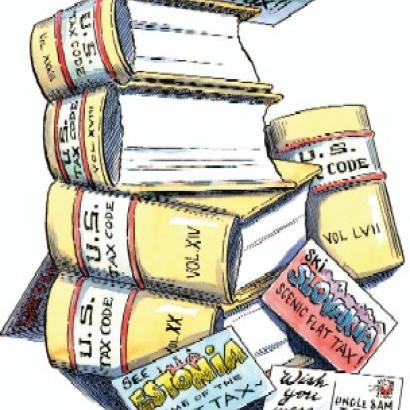- Budget & Spending
- Economics
- Law & Policy
- Regulation & Property Rights
On December 10, 1981, Robert Hall and I first published on the editorial page of the Wall Street Journal our proposal to replace the federal income tax with a low, simple, flat tax. The article, titled “A Proposal to Simplify Our Tax System,” displayed the iconic postcard that became the symbol of the flat tax. Our system was so simple that an individual or business could file a federal income tax return on a postcard-sized form.
The flat tax picked up considerable steam in the United States during the next few years, culminating in President Reagan’s Tax Reform Act of 1986. Two rates of 15 and 28 percent replaced multiple tax brackets with a top rate of 50 percent. From that point, the flat tax lost momentum. In 1990, in exchange for spending cuts that failed to materialize, President George H.W. Bush signed the Omnibus Budget Reconciliation Act that included a 31 percent rate on “the rich.” On August 10, 1993, President Clinton signed a similar act, which passed in Congress by exactly one vote in the House of Representatives, adding two further brackets of 36 and 39.6 percent.
When control of Congress passed into Republican hands in 1995, House majority leader Dick Armey put the flat tax back into the limelight. Armey, Steve Forbes, and other political leaders talked up the flat tax during the next few years, but it never came to the floor of the House or Senate for a vote.
Ideas, however, have a way of cropping up again in unexpected places. Against the advice of Western economists, the newly independent country of Estonia enacted a flat tax effective January 1, 1994. It set the rate at 26 percent to balance its budget. It has since lowered the rate on several occasions, and the tax is scheduled to fall to 20 percent in 2009. Estonia has also abolished its corporate income tax, imposing only the same flat rate on distributed dividends. Estonia’s budget has been in surplus since 2001.
Estonia set off an avalanche of flat taxes: in 1995 by Latvia (25 percent) and Lithuania (33 percent, to be reduced to 24 percent before the end of the decade). But the big story was Russia, which adopted a 13 percent flat tax, down from a top rate of 30 percent, effective January 1, 2001. In the four-plus years since it was adopted, real ruble revenues, adjusted for inflation, have more than doubled.
| Just weeks ago, the new nation of Macedonia implemented a 12 percent flat tax that it hopes will give it an edge in Europe. |
Next came Serbia in 2003, with a comprehensive 14 percent flat tax on personal and corporate income. Taking a page from Russia’s playbook, in 2004 Ukraine replaced its five-bracket income tax, ranging from 10 to 40 percent, with a 13 percent flat tax. That year Slovakia also replaced its five-bracket tax, ranging from 10 to 38 percent, with a 19 percent flat tax on both personal and corporate income. Double taxation of corporate income was eliminated.
Georgia followed Slovakia with a 12 percent flat tax and Romania with a 16 percent flat tax on both personal and corporate income, both taking hold January 1, 2005. Romania’s Finance Ministry has reported that income-tax revenue for the first eight months of 2006 greatly exceeded estimates and that the state budget had a significant surplus at the end of July, amounting to 1.12 percent of the gross domestic product.
The flat tax continued to pick up steam in 2006, spreading beyond Central and Eastern Europe. On February 1, 2006, President Kurmanbek Bakiyev of Kyrgyzstan signed into law modifications in the country’s tax code that established a 10 percent flat tax. It replaced the current corporate tax of 20 percent and the individual income tax with rates between 10 and 20 percent. Shortly thereafter, the president of neighboring Kazakhstan said his country would consider a flat tax in 2007.

Last July, the people of Macedonia voted to establish their own country. One of the main pillars of new Prime Minister Nikola Gruevski’s 100-point reform program was a flat tax, which came into being in January 2007 at 12 percent—and is scheduled to diminish to 10 percent in 2008. It replaced a corporate tax rate of 15 percent and personal income tax rates that ranged between 15 and 24 percent. The purpose of the low 10 percent flat tax is to give Macedonia one of the lowest tax rates in Europe to help it emulate the success of Estonia, Latvia, and Lithuania, which experienced strong economic growth after the adoption of their flat taxes.
Also in July, the tiny island of Mauritius, located in the Indian Ocean about 1,500 miles off the southeast coast of Africa, approved its 2006–07 budget. The signal feature of it is the advent, on July 1, 2009, of a 15 percent flat tax on personal and corporate income. That tax will replace the current personal income tax of two rates, 15 percent on taxable income to 25,000 rupees (about $800) and 25 percent on the rest. It will eliminate much of the complexity and many of the current deductions and credits in the current system. The 15 percent flat tax will also replace the existing 25 percent tax on corporate income.
| Taxpayers in Rhode Island and Utah can choose to pay the lower of the flat tax without any deductions or the standard income tax with deductions. Other legislatures are exploring similar options. |
In late May 2006, Kuwait indicated that it was studying a proposal to introduce an income tax at a flat rate of 10 percent. The draft law is to be studied by the cabinet and, if approved, sent to the country’s Parliament for consideration.
Several other developments warrant mention. Guernsey, a British Crown dependency in the Channel Islands off the west coast of France, has had for many years a 20 percent flat tax on corporate and personal income. Last July, its Parliament approved a zero corporate tax rate and capped the maximum tax on individuals at £250,000. The cap means that tax rates decline once taxable income exceeds £1,250,000, transforming the territory’s flat tax into a degressive tax.
The new president of Mexico, Felipe Calderón, has pledged to introduce a flat tax to simplify Mexico’s tax code and improve tax collection, which at just 11 percent of gross domestic product is insufficient to fund social development and improve the country’s physical infrastructure.
In the United States, the federal income tax has been further complicated by something known as the alternative minimum tax (AMT). The AMT was originally enacted to prevent individuals from eliminating most of their federal income-tax liabilities through numerous deductions and tax shelters. Under the AMT, taxpayers pay the higher of either the AMT, assessed at a flat rate of 28 percent, or the regular income tax.
Something quite new and different has been happening at the state level. Before 2006, six states maintained flat-rate income taxes: Colorado (4.63 percent), Illinois (3.0 percent), Indiana (3.4 percent), Massachusetts (5.3 percent), Michigan (3.07 percent), and Pennsylvania (3.07 percent). Last year, Rhode Island and Utah adopted optional flat taxes of 5.5 and 5.35 percent, respectively. In contrast with the federal AMT, in which taxpayers must pay the higher of the AMT or the regular income tax, state taxpayers in Rhode Island and Utah can choose to pay the lower of the flat tax without any deductions or the standard income tax with deductions. Other state legislatures are exploring similar optional flat taxes.
Perhaps the movement to optional flat taxes in the states will breathe new life into support for a federal flat tax, but one with a rate of 19 percent that Robert Hall and I first proposed—or even lower. Certainly not the AMT’s 28 percent!
















